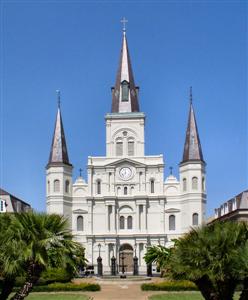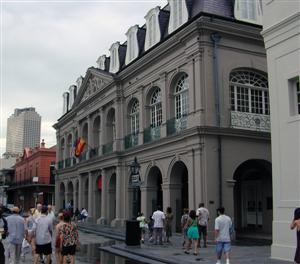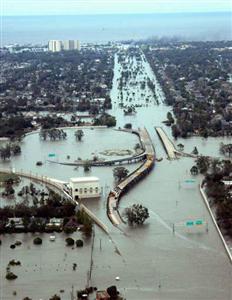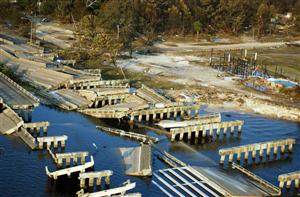October 2008 TRUCKER TALK
LIFE IN THE BIG EASY
BY WRITER & OWNER OPERATOR KIM GRIMM
New Orleans may be one of the most written about cities in America. Tropical in climate, lush in setting, exotic in architecture, sensual, if not hedonistic, in atmosphere, New Orleans is a worldly and bustling seaport whose very name evokes romance and myths. Over the years, the city has seen its share of disasters, but it has also seen its share of history and culture. New Orleans is truly a unique American city, unlike any other in this country.
I recently got a load down to New Orleans and was amazed at how much damage and destruction still exists there today – over three years after Hurricane Katrina. This was just a week before Gustav was set to hit landfall, and many were preparing for the worst again. But, thankfully, the levees in New Orleans held, and, for the most part, damage there was minimal. While driving through the city today, you’ll find one house that has been rebuilt, surrounded by others that still look like they must have just after Hurricane Katrina had hit. I had not been to New Orleans in over six years, and it was a sad sight to see.
 Some people say that we shouldn’t rebuild New Orleans at all, but many families have lived there for several generations and some have called it “home” all their lives. These people don’t want to leave – they want to stay and rebuild. In doing a little research for this article, I found that this was not the first time that the city of New Orleans has had to come back from nearly complete devastation. This town has been blown over, flooded and burned down several times before. Some have called it “the inevitable city on an impossible site” based on its precarious location between and below a river and a lake.
Some people say that we shouldn’t rebuild New Orleans at all, but many families have lived there for several generations and some have called it “home” all their lives. These people don’t want to leave – they want to stay and rebuild. In doing a little research for this article, I found that this was not the first time that the city of New Orleans has had to come back from nearly complete devastation. This town has been blown over, flooded and burned down several times before. Some have called it “the inevitable city on an impossible site” based on its precarious location between and below a river and a lake.
Nouvelle-Orleans (New Orleans) was founded in 1718 by the French Mississippi Company, under he direction of Jean-Baptiste Le Moyne de Bienville. It was named for Philippe II, Duke of Orleans, who was the Regent of France at the time. Ironically, the site for the city was chosen for its rare bit of high ground along the flood-prone banks of the lower Mississippi River and Lake Pontchartrain. In September of 1722 a hurricane hit New Orleans and blew down most of the structures in the city. After that, a French engineer named Adrien de Pauger laid out the city in a classic symmetrical gridiron pattern with a central square. This grid is still seen today in the “French Quarter” area of New Orleans, the site of the original settlement.
 Defeated in the Seven Years War (1756-63), France was compelled by the Treaty of Paris to cede Canada and all the territory between the Appalachians and the Mississippi, including West Florida and Louisiana, north of Lake Pontchartrain, to Britain. The rest of their Louisiana territory, including New Orleans, was handed over to the Bourbons of Spain. On March 21, 1788, the “Good Friday” fire destroyed 856 buildings in the city. The Spanish had hardly rebuilt the city, when a series of hurricanes and another fire, all in 1794, destroyed the only few buildings that had escaped the 1788 fire, as well as most of the new ones. As a result, the architecture of the Vieux Carre (French Quarter) is Spanish, not French, and most of the existing structures date from 1795 or after. After this fire, the city was rebuilt in the Spanish style with bricks, firewalls, iron balconies and courtyards, replacing the simpler French style wooden buildings.
Defeated in the Seven Years War (1756-63), France was compelled by the Treaty of Paris to cede Canada and all the territory between the Appalachians and the Mississippi, including West Florida and Louisiana, north of Lake Pontchartrain, to Britain. The rest of their Louisiana territory, including New Orleans, was handed over to the Bourbons of Spain. On March 21, 1788, the “Good Friday” fire destroyed 856 buildings in the city. The Spanish had hardly rebuilt the city, when a series of hurricanes and another fire, all in 1794, destroyed the only few buildings that had escaped the 1788 fire, as well as most of the new ones. As a result, the architecture of the Vieux Carre (French Quarter) is Spanish, not French, and most of the existing structures date from 1795 or after. After this fire, the city was rebuilt in the Spanish style with bricks, firewalls, iron balconies and courtyards, replacing the simpler French style wooden buildings.
Much of the neat old 18th Century architecture built during this time of Spanish rule is still present. Dating from this period are arguably the three most impressive structures in New Orleans, which include St. Louis Cathedral and the Cabildo and Presbytere buildings in Jackson Square. New Orleans remained under Spanish control until 1801, when it reverted back to French control. In April of 1803, Napoleon sold it to the United States in the Louisiana Purchase, which also included portions of more than a dozen present day states.
 French prefect Pierre Clemet de Laussat formally took control of New Orleans for France on November 30, 1803 only to hand it over to the United States on December 20, 1803. But in that short time, he had created the first city council. The city had a population of about 10,000 people at the end of the colonial era. The population grew in the 1830’s, and by 1840 it was around 102,000 people – which made it the 4th largest city in the nation and the largest in the South. In 1849 Baton Rouge replaced New Orleans as the capital of the state. Also in 1849, on May 3rd, a Mississippi River levee breach seventeen miles upriver from the city left 12,000 people in New Orleans homeless.
French prefect Pierre Clemet de Laussat formally took control of New Orleans for France on November 30, 1803 only to hand it over to the United States on December 20, 1803. But in that short time, he had created the first city council. The city had a population of about 10,000 people at the end of the colonial era. The population grew in the 1830’s, and by 1840 it was around 102,000 people – which made it the 4th largest city in the nation and the largest in the South. In 1849 Baton Rouge replaced New Orleans as the capital of the state. Also in 1849, on May 3rd, a Mississippi River levee breach seventeen miles upriver from the city left 12,000 people in New Orleans homeless.
Early in the Civil War, the city of New Orleans was captured by the Union without a battle in the city itself, so it was spared the destruction suffered by many other cities of the South. Throughout the Civil War and the Reconstruction period that followed, New Orleans again became an important city, hosting many political conventions and protest rallies. The city also hosted the 1884 World’s Fair, which was a financial failure, but it marked the beginning of the city’s tourist economy.
New Orleans sits in a bowl and has since it was built there. The city has always been susceptible to flooding, so it has always had to be protected by some sort of a levee system. Until the early 20th century, construction in New Orleans was largely limited because of the constraints of these old levees and the soft, swampy ground surrounding the city. In the 1910s, engineer and inventor A. Baldwin Wood enacted an ambitious plan to drain the city using large pumps of his own design. Wood’s pumps and drainage system allowed the city more space to expand. In 1927, a project to fill in the shoreline of Lake Pontchartrain and create levees along the lake side of the city was begun. Over the next 50 years, several levee and canal projects helped the city to grow and prosper.
 While New Orleans has always been one of the most visited cities in the United States, tourism boomed at the end of the 20th century and became a major force in the local economy. Areas of the French Quarter and the Central Business District, which had always been oriented towards local residential and business uses, switched over and began catering more to the tourist industry. In 1984, a century after hosting the World’s Fair, the city hosted another one, which further bolstered their strong tourist presence.
While New Orleans has always been one of the most visited cities in the United States, tourism boomed at the end of the 20th century and became a major force in the local economy. Areas of the French Quarter and the Central Business District, which had always been oriented towards local residential and business uses, switched over and began catering more to the tourist industry. In 1984, a century after hosting the World’s Fair, the city hosted another one, which further bolstered their strong tourist presence.
New Orleans has suffered several devastating floods over the years, but none as damaging as the one in 2005 caused by Hurricane Katrina, which hit New Orleans on August 29th as a huge Category 3 hurricane. At times, before it reached the city, it was a Category 5 hurricane with wind speeds clocked as high as 175 mph. Hurricane Katrina caused severe destruction along the entire Gulf Coast, especially in New Orleans, due to a strong storm surge that caused catastrophic failures of the levees around the city. Eventually, some 80% of New Orleans became flooded, and the floodwaters lingered for weeks. At least 1,836 people lost their lives due to the hurricane and the flooding, and more than $81 billion in damage was caused, making it the costliest natural disaster in U.S. history.
But the hurricane itself did not flood the city in 2005. Rather a series of failures in poorly designed levees and flood walls allowed water from the Gulf of Mexico and Lake Pontchartrain to flow into the city. The Industrial Canal was overwhelmed when the storm surge, funneled in by the Mississippi River Gulf Outlet, overflowed and breached levees and flood walls in several locations, flooding not only the Lower Ninth Ward, but also Eastern New Orleans and much of the Upper Ninth Ward.
Meanwhile, the water from storm-swollen Lake Pontchartrain poured into the city, first from a breach in the 17th Street Canal, and then from a pair of breaches in both sides of the London Avenue Canal. These canals were among those used to channel water pumped from city streets into the lake. The storm caused the flow to reverse, and as water levels rose, the entire drainage system failed. Examinations afterwards showed that water levels in these locations never topped the flood walls, but instead the levees failed at a water level supposedly within their safe tolerance.
 If we can do so much with all the technology we have today, why can’t we build better levees to help protect this historic old city and the people who live there? The Port of New Orleans is the 5th largest port in the United States. It also has the longest wharf in the world (2.1 miles long) and can accommodate 15 vessels at one time. The Port of New Orleans handles about 84 million short tons of cargo a year. This seems like something worth protecting, too. When I hear it would cost too much to do this work, I wonder how much it would cost to lose this historical place. How much could have been saved if they had built the levee system right to begin with? Years ago our Trucker Buddy class was in Violet, Louisiana. When we visited the class, you could see the tops of huge ships behind the levee near the school. They were right there on the other side. I will always wonder what happened to all those kids after Katrina.
If we can do so much with all the technology we have today, why can’t we build better levees to help protect this historic old city and the people who live there? The Port of New Orleans is the 5th largest port in the United States. It also has the longest wharf in the world (2.1 miles long) and can accommodate 15 vessels at one time. The Port of New Orleans handles about 84 million short tons of cargo a year. This seems like something worth protecting, too. When I hear it would cost too much to do this work, I wonder how much it would cost to lose this historical place. How much could have been saved if they had built the levee system right to begin with? Years ago our Trucker Buddy class was in Violet, Louisiana. When we visited the class, you could see the tops of huge ships behind the levee near the school. They were right there on the other side. I will always wonder what happened to all those kids after Katrina.
While many of the residents and businesses returned to rebuild the city, the effects of Katrina on the economy and demographics of New Orleans are expected to be dramatic and long term. As of July 2007, only about 60% of the pre-Katrina population had returned to the city. And with continued threats of hurricanes and the always-looming threat of floods, some have just decided to not go back. It is a shame, but I can certainly sympathize with these people.
Life in “The Big Easy” has not always been so easy, but it has usually been worth it. Hopefully, engineers can properly design and rebuild the levees and drainage systems in New Orleans to offer the protection this historic city, and any city for that matter, deserves. Maybe then, “Nawlins” can get back to being the wildly interesting, culturally stimulating, obnoxiously loud and entertaining city it has been for over 200 years.
